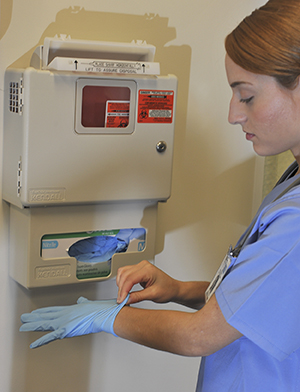Protecting Patients from Pressure Injuries
Pressure injuries are a growing problem in the healthcare setting. As a healthcare provider, you know that treating pressure injuries needs time and resources. This adds to your workload and puts an increased financial burden on facilities. Most important, pressure injuries cause pain and slow patient recovery. For these reasons, it’s vital to help prevent pressure injuries with attentive care and speed healing with correct treatment. It takes much less time and fewer resources to take the correct precautions to prevent pressure injuries than to treat them after they develop.
 |
| Use gloves to reduce the risk of infection. |
A complex problem
Pressure injuries are localized injuries to the skin or underlying tissue due to unrelieved pressure. This puts patients with immobility issues at greatest risk of developing pressure injuries. Other health problems, such as low immunity or advanced age, can also dramatically increase their risk. Yet even under such challenging conditions, pressure injuries can be prevented if correct steps are taken. The single most important issue regarding pressure injuries is prevention. Once a deep pressure injury forms, it is very hard to heal.
Steps for care
-
Assess each patient’s pressure injury risk on admission and throughout the patient’s stay.
-
Document your findings in detail.
-
Prevent injuries by limiting time patients spend in 1 position.
-
Involve family members in prevention efforts from the start.
-
Evaluate an existing pressure injury to determine its stage.
-
Treat pressure injuries quickly and correctly to speed healing.
-
Reduce risk of infection by using gloves and practicing the correct handwashing method.
Assess patient risk on admission
Every patient needs an initial risk assessment on admission. This involves performing a thorough skin assessment and gathering the patient’s information. The patient’s risk factors for pressure injuries should also be listed in the assessment. Use the risk assessment tool, such as the Braden Scale or Norton Scale, approved by your facility. Be sure to document whether your patient is any of the following:
-
Immobile or inactive
-
Underweight or overweight
-
Malnourished or dehydrated
-
Incontinent
-
Ill with systemic disease, such as diabetes or anemia
-
Recovering from surgery
-
Medicated with steroids or sedatives
-
Edematous
-
Sensory impaired or has an altered level of consciousness
Assess and document patient progress
Thorough assessment and correct documentation are vital for keeping track of patient progress. Both should be performed during each shift. Assessment and documentation also show that you and others at your facility are taking all the appropriate steps to prevent, manage, and treat pressure injuries. If your facility and electronic health record allow, you can upload a picture of the pressure injury to the patient's chart. Include pictures to show changes in the injury.
-
Assess with care. Correctly evaluate each patient to identify the pressure injury stage. Be particularly mindful when examining for pressure injuries in patients with dark skin tones. It can be difficult to determine changes in skin color. Have a good understanding of which parts of the body are particularly prone to developing pressure ulcers, such as the heels, elbows, hips, and over the buttocks. Also, know ways to decrease pressure and shear force on these areas.
-
Document with care. Once you’ve evaluated the patient and staged the injury, document your findings. Remember to be thorough and descriptive. Doing so gives a clear account of the wound’s state and progress. Document the following:
-
The patient’s level of pain using your facility’s pain scale
-
The length, width, and depth of the pressure injury
-
The type of wound tissue present, such as slough or granulation
-
If any exudate is present and its characteristics, such as if it is serosanguineous fluid. Also note the amount, color, consistency, and odor of drainage.
-
The presence of a tunnel, sinus tract or undermining. It is extremely useful to place your gloved finger into the wound and probe. This way, you can assess the depth of the wound and discover tracks that were previously not seen with a simple surface exam. You may also be able to feel bone in the base of the wound. This means a high risk for osteomyelitis, an infection of the underlying bone.
-
The condition of surrounding skin. Note any signs of infection, such as redness or warmth of skin, or injuries due to pressure, tape, or other causes.
Caution
Never reverse stage or “backstage” a healing pressure injury. For example, do not list a healing stage 4 as a stage 3. Instead, continue documenting the injury’s characteristics relative to its initial stage.
Professional resources
A variety of professional resources are available to help you care for and prepare your patients for discharge. Your facility may even have a wound care team that makes “skin care rounds.” Be sure to take advantage of all the resources available for preventing and treating pressure injuries. Follow your facility’s protocol for referring patients to other specialists. Some of these specialists include:
-
Occupational therapist or physical therapist
-
Dietitian
-
Wound, ostomy, and continence nurse
-
Surgeon
-
Infectious disease specialist
-
Diabetes educator
Online Medical Reviewer:
Heather M Trevino BSN RNC
Online Medical Reviewer:
Marianne Fraser MSN RN
Online Medical Reviewer:
Shaziya Allarakha MD
Date Last Reviewed:
8/1/2024
© 2000-2025 The StayWell Company, LLC. All rights reserved. This information is not intended as a substitute for professional medical care. Always follow your healthcare professional's instructions.